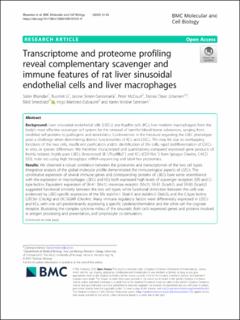Transcriptome and proteome profiling reveal complementary scavenger and immune features of rat liver sinusoidal endothelial cells and liver macrophages
Bhandari, Sabin; Li, Ruomei; Simon-Santamaria, Jaione; McCourt, Peter Anthony; Johansen, Steinar Daae; Smedsrød, Bård; Martinez, Inigo Zubiavrre; Sørensen, Karen Kristine
Peer reviewed, Journal article
Published version
Permanent lenke
https://hdl.handle.net/11250/2731790Utgivelsesdato
2020Metadata
Vis full innførselSamlinger
Originalversjon
Bhandari, S., Li, R., Simon-Santamaria, J., McCourt, P., Johansen, S. D., Smedsrød, B., Martinez-Zubiaurre, I. & Sørensen, K. K. (2020). Transcriptome and proteome profiling reveal complementary scavenger and immune features of rat liver sinusoidal endothelial cells and liver macrophages. BMC Molecular and Cell Biology, 21:85. doi: 10.1186/s12860-020-00331-9Sammendrag
Background
Liver sinusoidal endothelial cells (LSECs) and Kupffer cells (KCs; liver resident macrophages) form the body’s most effective scavenger cell system for the removal of harmful blood-borne substances, ranging from modified self-proteins to pathogens and xenobiotics. Controversies in the literature regarding the LSEC phenotype pose a challenge when determining distinct functionalities of KCs and LSECs. This may be due to overlapping functions of the two cells, insufficient purification and/or identification of the cells, rapid dedifferentiation of LSECs in vitro, or species differences. We therefore characterized and quantitatively compared expressed gene products of freshly isolated, highly pure LSECs (fenestrated SE-1/FcγRIIb2+) and KCs (CD11b/c+) from Sprague Dawley, Crl:CD (SD), male rats using high throughput mRNA-sequencing and label-free proteomics.
Results
We observed a robust correlation between the proteomes and transcriptomes of the two cell types. Integrative analysis of the global molecular profile demonstrated the immunological aspects of LSECs. The constitutive expression of several immune genes and corresponding proteins of LSECs bore some resemblance with the expression in macrophages. LSECs and KCs both expressed high levels of scavenger receptors (SR) and C-type lectins. Equivalent expression of SR-A1 (Msr1), mannose receptor (Mrc1), SR-B1 (Scarb1), and SR-B3 (Scarb2) suggested functional similarity between the two cell types, while functional distinction between the cells was evidenced by LSEC-specific expression of the SRs stabilin-1 (Stab1) and stabilin-2 (Stab2), and the C-type lectins LSECtin (Clec4g) and DC-SIGNR (Clec4m). Many immune regulatory factors were differentially expressed in LSECs and KCs, with one cell predominantly expressing a specific cytokine/chemokine and the other cell the cognate receptor, illustrating the complex cytokine milieu of the sinusoids. Both cells expressed genes and proteins involved in antigen processing and presentation, and lymphocyte co-stimulation.
Conclusions
Our findings support complementary and partly overlapping scavenging and immune functions of LSECs and KCs. This highlights the importance of including LSECs in studies of liver immunity, and liver clearance and toxicity of large molecule drugs and nano-formulations.

